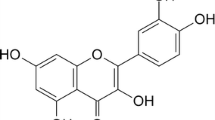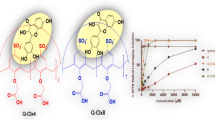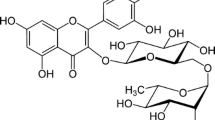Abstract
In this study, we aimed to investigate the inclusion complexes of the poorly water soluble flavonol, quercetin (QR) and its glycosides quercitrin (QRC) and rutin (RT), formed with β-cyclodextrin (β-CD), 2-hydroxyethyl-β-cyclodextrin (HE-β-CD), 2-hydroxypropyl-β-cyclodextrin (HP-β-CD), and methyl-β-cyclodextrin (M-β-CD) by using UV–Vis spectrophotometric and spectrofluorometric techniques. The formation constants (K f ) of 1:1 stoichiometric inclusion complexes were calculated from Benesi–Hildebrand equation using fluorescence spectroscopic data. Maximum inclusion ability was measured in the case of M-β-CD for rutin and quercitrin. Among CDs, HP-β-CD was most effective for complexing quercetin. The glycosylation of flavonoids considerably affects the binding process. The formation constants of flavonoid-CD complexes decrease after glycosylation. The influence of complexation of quercetin, rutin and quercitrin with native and modified β-CDs on their trolox equivalent antioxidant capacity (TEAC) was studied by the Cupric Ion Reducing Antioxidant Capacity method. It was found that the complexed polyphenols with CDs were much stronger antioxidants than free forms. Antioxidant capacity of HP-β-CD-complexed QR (compared to that of pure QR) was increased by 7.18 % in methanolic solution. Increase in TEAC for M-β-CD-complexed RT and M-β-CD-complexed QRC were measured as 4.30 and 14.8 %, respectively.





Similar content being viewed by others
References
Del Valle, E.E.M.: Cyclodextrins and their uses: a review. Process. Biochem. 39, 1033–1046 (2004)
Cai, Y., Gaffney, S.H., Lilley, T.H., Magnolato, D., Martin, R., Spencer, C.M., Haslam, E.: Polyphenol interactions, Part 4: model studies with caffeine and cyclodextrins. J. Chem. Soc. Perkin Trans. 2, 2197–2209 (1990)
Loftsson, T., Duchêne, D.: Cyclodextrins and their pharmaceutical applications. Int. J. Pharm. 329, 1–11 (2007)
Szejtli, J.: Introduction and general overview of cyclodextrin chemistry. Chem. Rev. 98, 1743–1754 (1998)
Kahn, A.R., Forgo, P., Stine, K.J., D´ Souza, V.T.: Methods for selective modifications of cyclodextrins. Chem. Rev. 98, 1977–1996 (1998)
Bennick, A.: Interaction of plant polyphenols with salivary proteins. Crit. Rev. Oral Biol. Med. 13, 184–196 (2002)
Di Carlo, G., Mascolo, N., Izzo, A., Papasso, F.: Flavonoids: old and new aspects of a class of natural therapeutic drugs. Life Sci. 65, 337–353 (1999)
Harbourne, J.B.: The Flavonoids: Advances in Research Since 1986. Chapman & Hall, London (1994)
Mercader-Ros, M.T., Lucas-Abellán, C., Fortea, M.I., Gabaldón, J.A., Núñez-Delicado, E.: Effect of HP-β-cyclodextrins complexation on the antioxidant activity of flavonols. Food Chem. 118, 769–773 (2010)
Bergonzi, M.C., Bilia, A.R., Di Bari, L., Mazzi, G., Vincieri, F.F.: Studies on the interactions between some flavonols and cyclodextrins. Bioorg. Med. Chem. Lett. 17, 5744–5748 (2007)
Alvarez-Parrilla, E., De La Rosa, L.A., Torres-Rivas, F., Rodrigo-Garcia, J., Gonzalez-Aguilar, G.: Complexation of apple antioxidants: chlorogenic acid, quercetin and rutin by β-Cyclodextrin (β-CD). J Incl. Phenom. Macro. 53, 121–129 (2005)
Kim, H., Choi, J., Jung, S.: Inclusion complexes of modified cyclodextrins with some flavonols. J. Incl. Phenom. Macro. 64, 43–47 (2009)
Jullian, C., Moyano, L., Yañez, C., Olea-Azar, C.: Complexation of quercetin with three kinds of cyclodextrins: an antioxidant study. Spectrochim. Acta A 67, 230–234 (2007)
Lucas-Abellán, C., Fortea, M.I., Gabaldón, J.A., Núñez-Delicado, E.: Encapsulation of quercetin and myricetin in cyclodextrins at acidic pH. J. Agric. Food Chem. 56, 255–259 (2008)
Liu, M., Dong, L., Chen, A., Zheng, Y., Sun, D., Wang, X., Wang, B.: Inclusion complexes of quercetin with three β-cyclodextrins derivatives at physiological pH: spectroscopic study and antioxidant activity. Spectrochim. Acta A. 115, 854–860 (2013)
Dong, L., Liu, M., Chen, A., Wang, Y., Sun, D.: Solubilities of quercetin in three β-cyclodextrin derivative solutions at different temperatures. J Mol. Lipids. 177, 204–208 (2013)
Vijaya Sri, K., Kondaiah, A., Vijaya Ratna, J., Annapurna, A.: Preparation and characterization of quercetin and rutin inclusion complexes. Drug Dev. Indust. Pharm. 33, 245–253 (2007)
Calabro, M.L., Tommasini, S., Donato, P., Raneri, D., Stancanelli, R., Ficarra, P., Ficarra, R., Costa, C., Catania, S., Rustichelli, C., Gamberini, G.: Effects of α- and β-cyclodextrin complexation on the physico-chemical properties and antioxidant activity of some 3- hydroxyflavones. J. Pharm. Biomed. Anal. 35, 365–377 (2004)
Jullian, C., Orosteguis, T., Perez-Cruz, F., Sanchez, P., Mendizabal, F., Olea-Azar, C.: Complexation of morin with three kinds of cyclodextrin. A thermodynamic and reactivity study. Spectrochim. Acta A 71, 269–275 (2008)
Yu, Z., Cui, M., Yan, C., Song, F., Liu, Z., Liu, S.: Investigation of heptakis(2,6-di-O-methyl)-β-cyclodextrin inclusion complexes with flavonoid glycosides by electrospray ionization mass spectrometry. Rapid Commun. Mass Spectrom. 21, 683–690 (2007)
Calabro, M.L., Tommasini, S., Donato, P., Stancanelli, R., Raneri, D., Catania, S., Costa, C., Villari, V., Ficarra, P., Ficarra, R.: The rutin/beta-cyclodextrin interactions in fully aqueous solution: spectroscopic studies and biological assays. J. Pharm. Biomed. Anal. 36, 1019–1027 (2005)
Haiyun, D., Jianbin, C., Guomei, Z., Shaomin, S., Jinhao, P.: Preparation and spectral investigation on inclusion complex of beta-cyclodextrin with rutin. Spectrochim. Acta A 59, 3421–3429 (2003)
Nguyen, T.A., Liu, B., Zhao, J., Thomas, D.S., Hook, J.M.: An investigation into the supramolecular structure, solubility, stability and antioxidant activity of rutin/cyclodextrin inclusion complex. Food Chem. 136, 186–192 (2013)
Şamlı, M., Bayraktar, O., Korel, F.: Characterization of silk fibroin based films loaded with rutin-β-cyclodextrin inclusion complexes. J. Inc. Phenom. Macrocycl. Chem. 80, 37–49 (2014)
Wang, Y., Qiao, X., Li, W., Zhou, Y., Jiao, Y., Yang, C., Dong, Y., Inoue, Y., Shuang, S.: Study on the complexation of isoquercitrin with β-cyclodextrin and its derivatives by spectroscopy. Anal. Chim. Acta 650, 124–130 (2009)
Jullian, C., Cifuentes, C., Alfaro, M., Miranda, S., Barriga, G., Olea-Azar, C.: Spectroscopic characterization of the inclusion complexes of luteolin with native and derivatized β-cyclodextrin. Bioorganic Med. Chem. 18, 5025–5031 (2010)
Chakraborty, S., Basu, S., Lahiri, A., Basak, S.: Inclusion of chrysin in β-cyclodextrin nanocavity and its effect on antioxidant potential of chrysin: a spectroscopic and molecular modeling approach. J. Mol. Struct. 977, 180–188 (2010)
Tommasini, S., Calabro, M.L., Stancanelli, R., Donato, P., Costa, C., Catania, S., Villari, V., Ficarra, P., Ficarra, R.: The inclusion complexes of hesperetin and its 7-rhamnoglucoside with (2-hydroxypropyl)-β-cyclodextrin. J. Pharm. Biomed. Anal. 39, 572–580 (2005)
Folch-Cano, C., Jullian, C., Speisky, H., Olea-Azar, C.: Antioxidant activity of inclusion complexes of tea catechins with β-cyclodextrins by ORAC assays. Food Res. Int. 43, 2039–2044 (2010)
Górnas, P., Neunert, G., Baczyński, K., Polewski, K.: Beta-cyclodextrin complexes with chlorogenic and caffeic acids from coffee brew: spectroscopic, thermodynamic and molecular modelling study. Food Chem. 114, 190–196 (2009)
Li, J., Zhang, M., Chao, J., Shuang, S.: Preparation and characterization of the inclusion complex of baicalin (BG) with β-CD and HP-β-CD in solution: an antioxidant ability study. Spectrochim. Acta A 73, 752–756 (2009)
Çelik, S.E., Özyürek, M., Tufan, A.N., Güçlü, K., Apak, R.: Spectroscopic study and antioxidant properties of the inclusion complexes of rosmarinic acid with natural and derivative cyclodextrins. Spectrochim. Acta A 78, 1615–1624 (2011)
Benesi, H.A., Hildebrand, J.H.: A spectrophotometric investigation on the interaction of iodine with aromatic hydrocarbons. J. Am. Chem. 71, 2703–2707 (1949)
Apak, R., Güçlü, K., Özyürek, M., Karademir, S.E.: Novel total antioxidant capacity index for dietary polyphenols and vitamins C and E, using their cupric ion reducing capability in the presence of neocuproine: CUPRAC method. J. Agric. Food Chem. 52, 7970–7981 (2004)
Lu, Z., Cheng, B., Hu, Y., Zhang, Y., Zou, G.: Complexation of resveratrol with cyclodextrins: solubility and antioxidant activity. Food Chem. 113, 17–20 (2009)
Singh, R., Bharti, N., Madan, J., Hiremath, S.N.: Characterization of cyclodextrin inclusion complexes—a review. J. Pharm. Sci. Tech. 2, 171–183 (2010)
Smulevich, G., Feis, A., Mazzi, G., Vincieri, F.F.: Inclusion complex formation of 1,8-dihydroxyanthraquinone with cyclodextrins in aqueous solution and in solid state. J. Pharm. Sci. 77, 523–526 (1988)
Tommasini, S., Raneri, D., Ficarra, R., Calabro, M.L., Stancanelli, R., Ficarra, P.: Improvement in solubility and dissolution rate of flavonoids by complexation with β-cyclodextrin. J. Pharm. Biomed. Anal. 35, 379–387 (2004)
Brewster, M.E., Loftsson, T.: Cyclodextrins as pharmaceutical solubilizers. Adv. Drug Deliver Rev. 59, 645–666 (2007)
Cao, H., Wu, D., Wang, H., Xu, M.: Effect of the glycosylation of flavonoids on interaction with protein. Spectrochim. Acta A 73, 972–975 (2009)
Xiao, J., Cao, H., Wang, Y., Zhao, J., Wei, X.: Glycosylation of dietary flavonoids decreases the affinities for plasma protein. J. Agric. Food Chem. 57, 6642–6648 (2009)
Dangles, O., Dufour, C., Bret, S.: Flavonol-serum albumin complexation. Two-electron oxidation of flavonols and their complexes with serum albumin. J. Chem. Soc. Perkin Trans. 2, 737–744 (1999)
Bi, S.Y., Ding, L., Tian, Y., Song, D.Q., Zhou, X., Liu, X.: Investigation of the interaction between flavonoids and human serum albumin. J. Mol. Struct. 703, 37–45 (2004)
Apak, R., Güçlü, K., Demirata, B., Özyürek, M., Çelik, S.E., Bektaşoğlu, B., Berker, K.I., Özyurt, D.: Comparative evaluation of total antioxidant capacity assays applied to phenolic compounds, and the CUPRAC assay. Molecules 12, 1496–1547 (2007)
Tütem, E., Apak, R., Baykut, F.: Spectrophotometric determination of trace amounts of copper(I) and reducing agents with neocuproine in the presence of copper (II). Analyst 116, 89–94 (1991)
Ozyurek, M., Güçlü, K., Apak, R.: The main and modified CUPRAC methods of antioxidant measurement. Trac- Trend Anal. Chem 30, 652–664 (2011)
Stražišar, M., Andrenšek, S., Šmidovnik, A.: Effect of β-cyclodextrin on antioxidant activity of coumaric acids. Food Chem. 110, 636–642 (2008)
Çelik, S.E., Özyürek, M., Güçlü, K., Apak, R.: Solvent effects on the antioxidant capacity of lipophilic and hydrophilic antioxidants measured by CUPRAC, ABTS/persulphate and FRAP Methods. Talanta 81, 1300–1309 (2010)
Piel, G., Piette, M., Barillaro, V., Castagne, D., Evrard, B., Delattre, L.: Study of the relationship between lipid binding properties of cyclodextrins and their effect on the integrity of liposomes. Int. J. Pharm. 338, 35–42 (2007)
Acknowledgments
Authors would like to thank Istanbul University Research Fund for the support given to the projects (UDP-43471, BYP-43699, YADOP-43696) and Istanbul University-Application and Research Center for the Measurement of Food Antioxidants.
Author information
Authors and Affiliations
Corresponding author
Rights and permissions
About this article
Cite this article
Çelik, S.E., Özyürek, M., Güçlü, K. et al. Antioxidant capacity of quercetin and its glycosides in the presence of β-cyclodextrins: influence of glycosylation on inclusion complexation. J Incl Phenom Macrocycl Chem 83, 309–319 (2015). https://doi.org/10.1007/s10847-015-0566-z
Received:
Accepted:
Published:
Issue Date:
DOI: https://doi.org/10.1007/s10847-015-0566-z




